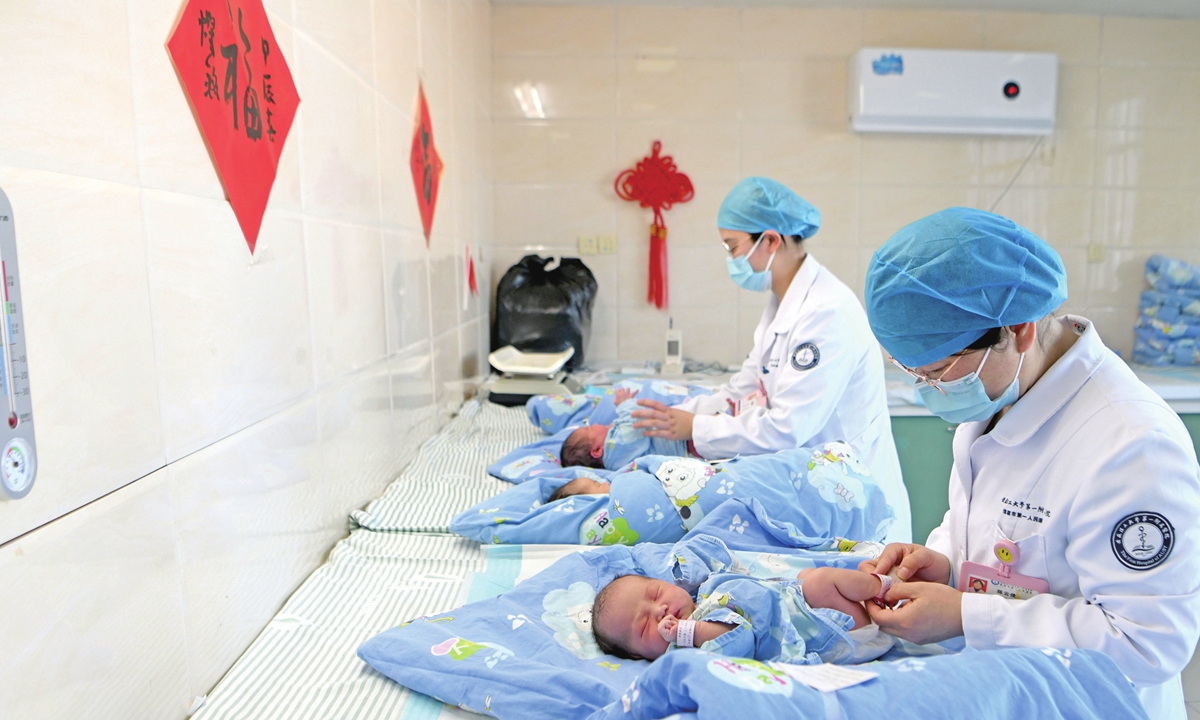
Nurses take care of dragon babies at the First Hospital of Anhui University of Science and Technology in Huainan, East China’s Anhui Province, on February 16, 2024, the first day of the Year of the Dragon. Photo: VCG
A promotional event for the 2025 World Health Day was held on Monday at the academic hall of Peking Union Medical College Hospital in Beijing. Centered on the theme ensuring maternal and infant health, the event showcased China's achievements and innovations in maternal and child healthcare.
The reporters from the Global Times learned from the event that in 2024, the national maternal mortality rate was 14.3 per 100,000, while the infant mortality rate dropped to 4.0 per 1,000 and the mortality rate of under-five-year-old children fell to 5.6 per 1,000, reaching historic lows. China's core health indicators for women and children now rank among the top in upper-middle-income countries globally, the Global Times learned.
Data from the China's National Health Commission at the event shows that maternal and infant safety in China has been effectively safeguarded nationwide.
During the three-year COVID-19 pandemic, the maternal mortality rate has maintained an average annual decline rate of approximately four percent, while infant and under-five mortality rates dropped by about five percent each year.
In 2024, China recorded a maternal mortality rate of 14.3 per 100,000, with infant mortality rate at 4 per 1,000 and under-five mortality rate at 5.6 per 1,000—reaching historic lows.
China's core maternal and child health indicators now rank among the top in global upper-middle-income countries and have been recognized by the World Health Organization (WHO) as one of the 10 high-performing nations in maternal and child health outcomes.
China has also made notable progress in combating major diseases affecting women and children, said the event.
Data reveals that infant mortality and under-five-year-old child mortality caused by birth defects have both decreased by over 30 percent compared to five years ago. Meanwhile, the incidence of five severe disabling birth defects—including neural tube defects and Down syndrome—has dropped by 21 percent.
China's health authorities have ramped up efforts to address critical issues such as myopia, childhood obesity, and childhood autism, achieving a 95.1 percent coverage rate for eye health and vision screenings among children aged 0-6 nationwide, reporters from the Global Times learned. In 2022, the overall myopia rate among children and adolescents and the myopia rate among six-year-olds decreased by 1.7 and 1.8 percentage points respectively compared to 2018 levels.
Efforts to eliminate mother-to-child transmission of HIV, syphilis, and hepatitis B have reduced the national HIV mother-to-child transmission rate to 1.3 percent, with nine provinces already achieving elimination targets.
Since 2009, China has integrated cervical and breast cancer screenings into public health programs, conducting 280 million cervical cancer screenings and 190 million breast cancer screenings to date. HPV vaccination rates are rising, with 15 provinces now offering free HPV vaccines to girls aged 13-14 through government health programs—benefiting around 4 million girls annually.
In addition to domestic contributions, China has also actively expanded international cooperation to promote maternal and child health worldwide, according to the event.
According to official data, 117 Chinese obstetricians, gynecologists, and pediatricians are currently providing routine medical care for pregnant women, infants, and children in recipient countries. They also train local healthcare workers and conduct
China has collaborated with countries and regions including Sierra Leone, Malawi, Zanzibar, Guinea-Bissau, Burundi, The Gambia, and Cambodia on maternal and child health initiatives.
In cooperation with UNICEF, China launched the maternal and child health training base program in countries of the Belt and Road Initiative (BRI), aimed at reducing maternal and neonatal mortality in African countries. So far, 15 online and offline training sessions have been held for healthcare professionals.
China supported the creation of a reproductive medicine center at Mali Hospital, where the country's first test-tube baby, and the first in a Malian public hospital, was born in 2024. In South Sudan, a joint project of a cervical cancer screening center has facilitated nearly 4,000 services, providing critical support for cervical disease screening, early diagnosis, and treatment. In Sierra Leone, Chinese medical teams launched the country's first HPV genotyping program across multiple facilities, contributing to national efforts to eliminate cervical cancer by 2030.




